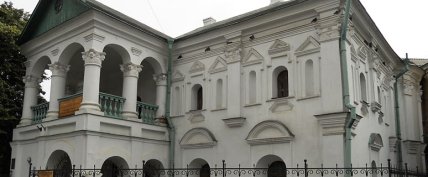Discover the appearance and location of Emperor Peter I's house in Kyiv, complete with photos.
Kyiv boasts numerous fascinating locations with incredible histories. However, few are aware that on Podil stands the house of Peter I, built back in the late 17th century. This structure is regarded as the oldest stone building still standing in the capital, and it has stories to tell about the lives of many individuals.
"Telegraph" shares with readers the story of the legendary house of Peter I and addresses the most common question of whether this house is truly connected to the emperor.
The History of Peter I's House Construction
 9
9
Peter I's house was constructed at the turn of the 17th to 18th centuries, with the approximate year of completion being 1696. Initially, it belonged to the well-known Kyiv family of Bykovskyi, who owned many mansions in Podil.
The head of the family, Yan Bykovskyi, served as the city mayor — Kyiv's voivode — from 1687 to 1699. This is why the house is sometimes referred to as Bykovskyi's house.
In the 1730s, the house began to be renovated by Leonid Bykovskyi, Yan's grandson. However, he did not complete the work as he was appointed as a centurion and left. Construction continued for decades, and the house was fully completed only by the 1780s. At that time, the building was purchased by the Kyiv magistrate for a substantial sum of 3,000 rubles.
 0
0
Interior renovations were carried out, and from 1791, it housed the so-called "calming house," where troublemakers, drunks, and the insane were isolated from society.
People were held here against their will, and among the prisoners of this grim house was the renowned composer and author of masterpieces of Ukrainian spiritual music, Artemiy Vedel, who was held here for 9 years.
 1
1
In 1803, psychiatry was moved to the Kyrylivska hospital, and the house remained empty for several decades. During a major fire in Podil in 1811, the building suffered partial damage but survived. The next restoration occurred between 1817 and 1820.
 2
2
Subsequently, until the end of the 1860s, the house served as the Podil parish school. In the 1870s, it was home to the therapist doctor Yanovskyi. However, a permanent purpose for this building was still elusive. It also served as an orphanage and military barracks.
During the Soviet era, the house was converted back into residential space, turning it into communal apartments. The residents disliked it here, annoyed by the excessively thick walls and narrow windows.
 3
3
In 1978, Kyiv decided to transfer Peter I's house to the Museum of History, which it belongs to today. The house is a branch of the main museum, specifically the charity museum in Kyiv.
Currently, the museum is named "Kam'yanytsia kyivskogo voivody."
Did Peter I Really Live in This House?
 4
4
It is believed that Tsar Peter I stayed in this house during his visit to Kyiv in 1706. There is also a popular belief that the house belonged to Hetman Ivan Mazepa, who personally hosted the tsar.
These legends were widely circulated; however, most historians today disagree with them. No tsar stayed here, and the story of Peter I's presence is considered an urban legend. Yet, the unofficial name in honor of the ruler remains to this day.
 5
5
Where to Find Peter I's House in Kyiv
 6
6
Peter I's house in Kyiv is located in Podil, at 6/8 Konstytutsii Street. The museum house is situated right next to the Contract Square metro station on the blue metro line.
Address: 6/8 Konstytutsii Street.
 7
7
It’s worth noting that in 1857, a wooden Triumphal Arch was built at the site of the modern Air Fleet Bridge in Kyiv. This atypical structure for the capital was erected in honor of the visit of Emperor Alexander II and Maria Alexandrovna. The capital's arch is associated with a very interesting and convoluted history known to only a few.
Previously, "Telegraph" reported on a magnificent Kyiv mansion belonging to a countess, which at one point turned into a horrific torture chamber. The Uvarova estate is a local architectural monument, yet terrible things occurred within its walls that would freeze the blood in one's veins.